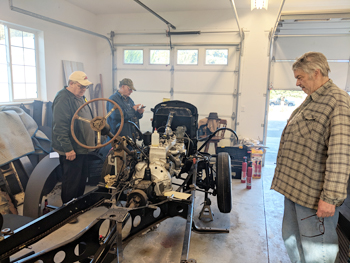Vintage Engine Startup From Storage
Check Before Starting
 Check Oil - drain if old oil has been left in engine and replace with new. When draining, check to see if any water has been in bottom of pan.
Check Oil - drain if old oil has been left in engine and replace with new. When draining, check to see if any water has been in bottom of pan.
- Check water or antifreeze in radiator. Note condition (especially rust) and top off prior to startup.
- Check Battery connections. - older vehicles are normally 6 volt and positive ground
- Check gas tank - if it has very old gas, the tank should be flushed and cleaned of old gas and rust
- Check fuel line condition and check for blockage. Replace lines if showing rusting/pitting. Blow from disconnected fuel line at carburetor and have a second person listen for bubbling in gas tank - which will indicate either an open or blocked line. (With gas in tank)
- Check ignition wiring circuits - from ignition key or button through coil, distributor and on to spark plugs. Note condition and replace as necessary. File the points while doing inspection to remove oxidation and wear. (If not replacing them)
- If distributor has been removed for any reason, make sure timing is correct per service manual instructions.
- Check fuel pump to see if there is a glass bowl on it, and if so, if it contains debris.
- Check any in-line fuel filter to see if there is debris. Clean or replace as necessary
- Check gasket on fuel pump bowl for leaking. Replace if necessary.
- Remove air filter from carburetor until after first startup. Inspect carburetor for linkage issues or signs of fuel leakage. Clean and add oil to air filter if necessary - for later installation.
Initial Startup Procedures
- Remove spark plugs and turn engine over until proper oil pressure reads on gauge. Removal of plugs will make turning engine over much easier on the starter motor. Engine should have oil pressure show prior to startup to assure bearings will not be damaged.
- With plugs still removed, check compression on all cylinders and make note of the reading for each. All cylinders should have nearly equal compression, and no single cylinder should be much lower than the others. If the cylinder pressures are low or vary a lot, add something like Marvel Mystery Oil to help seal rings. (IF this does not raise pressures, wait until after initial startup and run and then re-check compression. Our test engine went from 60 psi to 90 psi on the cylinders after running the engine for 2-3 minutes!)
- Replace plugs and re-connect spark plug wires.
- Get out a fire extinguisher and keep it handy during startup!
- Attempt first startup. Rather than use "engine starting fluid" directly into carburetor, use a small spray bottle with gasoline in it. Spray gas into the throat of the carburetor while a second person is turning the engine over. (spraying starting fluid directly into the engine can scrub all oil off of the cylinder walls and cause damage).
- Do not crank over the engine for long extended periods - allow starter motor to rest periodically.
- It may take some time to have the engine start up, and an even longer time to get it to run on it's own. It takes much longer than expected on older cars with mechanical fuel pumps to get gas from tank to carb. During initial startup, spray gas into the carb to keep the engine running. If the engine will absolutely not start using gas - as a last resort spray starter fluid into carb throat - but from a few inches away so it is a mist.
- IF the engine will not start up at all, determine what might be wrong. Usually, this can be broken down into a) no fuel to carb, or b) no spark to plugs.
- The fuel line can be disconnected at the carburetor, and a small bottle put over it. Cranking the engine over, see if gas is coming through the line to the carb. (this is AFTER the initial startup procedure when time is allowed for fuel to reach the carburetor from the gas tank). If gas is coming through the line, re-install the line to the carb. If there is no gas coming through the line, you will need to back track from the line, through any filters, through the fuel pump and then through lines to the fuel tank. Obstructions or fuel pump failures could be causing the problem.
- If fuel is getting to the carburetor, it would make good sense to check and see if a spark is getting to the spark plugs. You can disconnect one plug wire and (with an insulated glove) hold the plug wire end close to the metal block. When the engine is turned over, a spark should be seen arcing from the wire to the block. A better method is to use an in line spark tester, which connects between the plug wire and the plug. It has a clear window which shows the spark if it is present (and in a safe non - shocking way!) If there is no spark present, testing and inspection of all ignition wiring should be done, including a test of the coil.
- As a note of caution: Do not EVER leave the ignition switch or key ON if the engine dies. It is very easy to forget this and get distracted during these start up procedures. Electrical current will continue to be delivered to the coil, it will overheat and quite probably explode. I know this for a fact.
- If you have spark to the plugs, and you have checked the fuel line up to the carburetor, the next most logical problem area is within the carburetor itself. It could be a sticking float / float needle, or clogged jets and passages within the carburetor. This is especially true if old gas has been left in the carb for years. Disassembly and rebuilding of the carb may be necessary in these situations. Kits are available for this. Also note that on old carburetors, the gasket materials were not resistant to today's gas with ethanol in it. A rebuild kit should specify that it is compatible with ethanol mixed fuels.
Notes and Cautions
Initial startup of an engine using modern gas will not cause a problem. After the first startups, it is imperative that either the carb and fuel pump gaskets be upgraded to ethanol compatible materials, or 100% pure gas must be used (expensive but available at marinas and selected gas stations). It makes better sense to upgrade the gaskets for long term insurance.
Following initial startup, you may well have to set the spacing on the points in the distributor, the advance of the distributor, and also the overall timing of the engine.
There are certainly other problems which can affect the startup of an engine. A bad capacitor in the distributor, worn distributor bushings, hung up linkages, and hidden corrosion in wiring can all cause problems. If the engine was running when it was last shut down, chances are the problems will be simpler - and generally confined to fuel and spark issues.
After the engine is running, be SURE that the oil pressure reads the proper pressure for specifications at certain RPM values. Not just "some" minimal pressure, but specified pressure. I personally burned up all the bearings in an engine I bought which had a worn oil pump that did not put out adequate pressure.
On older engines, there will typically be oil holes or caps of various types for the distributor, starter and generator - and often a grease fitting on the water pump. Make sure to address these areas before running the engine for extended periods of time.
Wrap Up
BE PATIENT ! ! ! This is really important. Work slowly and logically. Take notes as you go along if necessary. If things don't seem to be going well, slow down and rethink - or bring in others for advice. Don't panic! Problems are often simpler than they initially appear.
Thanks to Dennis Mowery, Chuck Willis and Randy Ealy for their input and assistance in starting up Randy's long dormant engine. PL


